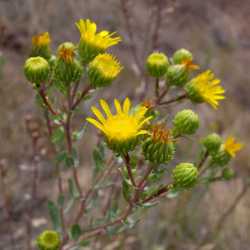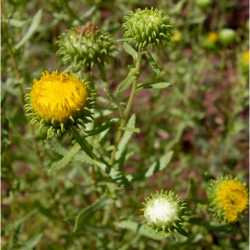Annuals, biennials, perennials, or subshrubs, 15-250+ cm (taprooted, rhizomatous in G. oölepis). Stems (1-6+) usually erect, sometimes ascending or decumbent to prostrate, simple or branched, glabrous or hairy, often gland-dotted and/or resinous. Leaves basal and cauline or mostly cauline; alternate; petiolate (proximal) or sessile (distal); cauline blades 1-nerved, oblong, obovate, oblanceolate, or spatulate to triangular, lanceolate, or linear (bases usually clasping), margins usually serrate to dentate, sometimes entire, crenate, or pinnatifid (especially proximal), faces usually glabrous and gland-dotted, sometimes hirsutulous, hirtellous, puberulous, scabridulous, villous, or stipitate-glandular. Heads radiate or discoid, in corymbiform to paniculiform arrays or borne singly. Involucres usually globose to hemispheric or broadly urceolate, sometimes campanulate to obconic, 5-25+ mm diam. (excluding phyllary apices). Phyllaries (persistent) 25-100+ in (3-)4-9+ series, 1-nerved or obscurely so (± flat, proximally and/or medially thickened), mostly filiform, linear, or lanceolate, usually unequal, sometimes subequal, bases usually ± chartaceous (apices ± herbaceous, looped, hooked, patent, recurved, straight, or incurved), abaxial faces usually glabrous and ± resinous. Receptacles flat or convex, ± pitted (pits sometimes flanked by membranous or setiform enations), epaleate. Ray florets 0 or 5-60+, pistillate, fertile; corollas yellow to orange. Disc florets (20-)100-200(-300+), bisexual and fertile (all or outer) or functionally staminate (ovaries not producing cypselae) corollas yellow, tubes shorter than gradually to abruptly ampliate throats, lobes 5, erect or spreading, ± deltate (equal); style-branch appendages linear or lanceolate to ± deltate. Cypselae (whitish or stramineous to gray, brown, or reddish) ellipsoid to obovoid, ± compressed, sometimes ± 3-4-angled (apices smooth, coroniform, or knobby), faces smooth, striate, ribbed, furrowed, or rugose, glabrous; pappi falling, of (1-)2-8[-15], straight or contorted to curled, smooth or barbellulate to barbellate, sometimes distally clavate, subulate scales, setiform awns, or bristles in 1 series (in G. ciliata, persistent or tardily falling, of 25-40 barbellate bristles subtending 8-15+ barbellate, setiform awns or subulate scales). x = 6.
The last attempt to account for the whole of Grindelia was by J. A. Steyermark (1934b). After comparing Steyermark´s treatment with specimens, one gets the impression that Steyermark had a keen eye for subtleties and trends in variation and that he sometimes assigned taxonomic ranks (species, variety, and forma) to trends rather than to what most botanists would consider to be taxa. Subsequently, writers of local and regional floras have felt obliged to recognize Steyermark´s 'taxa.' Here, some of Steyermark´s 'taxa' have been included within more broadly drawn circumscriptions; attention is called to them in discussions. Within and among populations of grindelias, some morphologic traits appear to vary more from plant to plant than in most genera of composites. M. P. Dunford (1964) reported grindelias he had tested to be 'essentially self-incompatible' and (1986) stated, '...Grindelia species are outcrossing and self-incompatible....' Some patterns of variation within Grindelia are similar to those found in genera characterized by apomictic seed production (e.g., local morphologic variants such as discoid plants in otherwise radiate taxa, hairy plants in otherwise glabrous taxa, narrow-leaved plants in otherwise broad-leaved taxa, etc.). See comments in discussion under 13. G. hirsutula. References here to hybrids are based on observations by M. A. Wetter and/or on statements by M. P. Dunford (1964, 1986) and J. A. Steyermark (1934b). Morphologic details and descriptive conventions for grindelias as treated here are: Margins of most cauline leaves of most grindelias are usually dentate to serrate and have sharp, apiculate to setose teeth. Some species characteristically have cauline leaves with ± crenate margins and rounded, obtuse, or truncate teeth tipped by resin globules. Sporadically, individual plants may have some teeth resin-tipped and some teeth apiculate; such specimens may be hybrids or may indicate that the developmental paths to the two forms may be easily redirected. Plants with margins of some or all leaves entire may be encountered in almost all species of Grindelia and may predominate in some plants, populations, or species. Leaf faces are usually gland-dotted with glands embedded in (or sessile in pits in) both the abaxial and adaxial epidermes. In some plants, populations, or species, the glands may be characteristically stipitate; developmental control for the different forms is apparently easily redi
Heads radiate or occasionally discoid, the rays mostly 12-45, yellow, pistillate and fertile; invol ±resinous, its bracts herbaceous-tipped, imbricate or subequal; receptacle flat or convex, naked; disk-fls yellow, the inner and often also the outer sterile; style-branches flattened, with externally hairy, lance-linear or occasionally very short appendages; achenes compressed to subquadrangular, scarcely nerved; pappus of 2-several firm, deciduous, often minutely serrulate awns; taprooted herbs, sometimes woody at the base, with alternate, ±resinous-punctate lvs and relatively large, hemispheric heads, the disk 1-3 cm wide. 50, New World.
Gleason, Henry A. & Cronquist, Arthur J. 1991. Manual of vascular plants of northeastern United States and adjacent Canada. lxxv + 910 pp.
©The New York Botanical Garden. All rights reserved. Used by permission.











